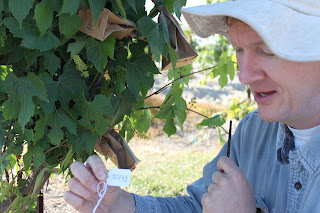The introduction of new insect pests damaging to grapes is an ongoing threat for California California
Just as grape growers learn they have made excellent progress toward eradicating EGVM, officials are expressing concern over a new exotic insect pest, the brown marmorated stink bug (BMSB). The BMSB is now found in 33 States. Although not established in California , it has been identified in Los Angeles and Solano Counties Eastern US . It has a large host range that includes grapes and many of the fruits and vegetables grown in California Mid-Atlantic States have reported losses of $37 million representing 18% of their fresh apple market. Growers and wineries are also concerned that the “stink” from any bugs accidentally crushed in wine or juice grapes could taint the product with off flavors. This insect should concern homeowners as well, since people in the Mid-Atlantic States have reported large populations of BMBS overwintering in their homes and becoming a nuisance.
BMSBs resemble some other California stinkbugs such as the rough stink bug, a beneficial predator of other insects. If you think you’ve found a BMSB, or any other odd or unique looking insect pest, you should collect it and bring it to your local university advisor, ag commissioner or state ag department entomologist for proper identification. Early identification of invasive pests is critical for protecting California
You can learn more about the BMSB and current research here.






